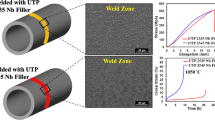Abstract
In this study, lithium/C-103 alloys heat pipes are proposed for sharp leading edge cooling. Three models of lithium/C-103 alloy heat pipes were fabricated. And their startup properties were tested by radiant heat tests and aerothermal tests. It is found that the startup temperature of lithium heat pipe was about 860 °C. At 1000 °C radiant heat tests, the operating temperature of lithium/C-103 alloy heat pipe is lower than 860 °C. Thus, startup failure occurs. At 1100 °C radiant heat tests and aerothermal tests, the operating temperature of lithium/C-103 alloy heat pipe is higher than 860 °C, and the heat pipe starts up successfully. The startup of lithium/C-103 alloy heat pipe decreases the leading edge temperature effectively, which endows itself good ablation resistance. After radiant heat tests and aerothermal tests, all the heat pipe models are severely oxidized because of the C-103 poor oxidation resistance. Therefore, protective coatings are required for further applications of lithium/C-103 alloy heat pipes.












Similar content being viewed by others
Abbreviations
- x:
-
Coordinate measured from center of model along span, mm
- l:
-
Chordwise surface distance measured from nose, mm
- L:
-
Length of lithium/C-103 heat pipe, mm
- Tiso :
-
Isothermal operating temperature, oC
- TCs :
-
Thermal couples
- Ps :
-
Saturated pressure of lithium (torr, 133.3 Pa)
- Ts :
-
Operating temperature of lithium\C-103 heat pipe (K)
- MLi :
-
Charging mass of lithium (g)
- Vcap :
-
Volume of capillary (cm3)
- ρ Li :
-
Density of lithium (g/cm3)
- σb :
-
Strength of C-103 alloy (MPa)
- δ:
-
Elongation of C-103 alloy (%)
References
Silverstein CC (1971) A feasibility study of heat pipe cooled leading edges for hypersonic cruise aircraft. NASA CR-1857
Niblock GA, Reeder JC, Huneidi F (1974) Four space shuttle wing leading edge concepts. J Spacecr Rocket 11:314–320
Alario JP, Prager RC (1972) Space shuttle orbit heat pipe application. NASA CR-128498
Colwell GT, (1990) Cooling hypersonic vehicle structures. Proceedings of 7th international heat pipe conference, Minsk, U.S.S.R.
Camarda CJ (1977) Analysis and radiant heat tests of a heat-pipe-cooled leading edge. NASA TN D-8468
Camarda CJ (1978) Aerothermal tests of a heat pipe cooled leading edge at mach 7. NASA TP-1320
Boman BL, Citrin KH, Garner EC, Stone JE (1989) Heat Pipes for Leading Edges of Hypersonic Vehicles. NASA CR-181922
Boman B, Elias T (1990) Tests of a sodium/Hastelloy X wing leading edge heat pipe for hypersonic vehicles. AIAA/ASME 5th joint Thermophysics and heat transfer conference, Seattle
Amir Faghri (1991) Analysis of frozen startup of high-temperature heat pipes and three-dimensional modeling of block-heated heat pipes. AD-A245 327, Depart of mechanical and material engineering wright state University Dayton, on 45435
Jong Hoon Jang, "A study of start-up Characteristics of a potassium heat pipe from the frozen state". Lewis Research Center Group, Brook Park, Ohio, NASA Contractor report 189173
Rosenfeld JH, Ernst DM, Lindemuth JE et al (2004) An overview of long duration sodium heat pipe tests [R]. Thermacore International, Inc., Lancaster
Rosenfeld JH, Minnerly KG, Dyson CM (2012) Ten year operating test results and post-test analysis of a 1/10 segment Stirling sodium heat pipe phase III final report[R]. Thermacore, Inc., Lancaster
Ai BC, Yu JJ, Chen SY (2011) The application of leading thermal protection technique on the scramjet. Proceeding of the 3rd Sino-Italian conference on space aerothermodynamics and hot structures. China academy of aerospace aerodynamics, shanghai, pp. 2-10
Lu Q, Han HT, Hu LF, Chen SY, Yu JJ, and Ai BC, (2017) “Preparation and Testing of nickelbased superalloy/sodium heat pipes”, Heat and Mass Transfer, 53: 3391-3397.
Glass DE, Camarda CJ (1999) Fabrication and testing of a leading-edge-shaped heat pipe. AIAA-99-4866. 36:6:921-923. https://doi.org/10.2514/2.3515
Leavenworth H, Claery RR, Bratton WD (1961) Solubility of structural metala in lithium” report no. PWAC-356, Pratt & Whitney Aircraft Division, united aircraft Corportion, under USAEC contract AT(11-1)-229
Destefano JR (1964) Corrosion of refractory metal by lithium. Report no. ORNL-3551, oak ridge National Labtory, oak ridge, Tennesee, under USAEC Contract W-7405-eng-26
Camarda CJ, Masek RV (1981) Design, analysis, and tests of a shuttle-type heat –pipe-cooled leading edge. J Spacecr 18:71–78
Kasen SD (2013) Thermal management at hypersonic leading edges. PH.D. Dissertation, University of Virginia
Li GY, Tu J (2001) Working fluid selection for high temperature heat pipes. 1:42-44. (In Chinese)
Li J, Shen Q, Cheng X (2012) Investigation of inflow total temperature effect on Kerosen-fueled low internal drag scramjet combustor performance. Physics Gases 7:4–11 (in chinese)
Acknowledgements
This work is supported by National Natural Sciences Foundation of China under Grant No.11172284.
Author information
Authors and Affiliations
Corresponding author
Rights and permissions
About this article
Cite this article
Ai, B., Chen, S., Yu, J. et al. Fabrication of lithium/C-103 alloy heat pipes for sharp leading edge cooling. Heat Mass Transfer 54, 1359–1366 (2018). https://doi.org/10.1007/s00231-017-2236-8
Received:
Accepted:
Published:
Issue Date:
DOI: https://doi.org/10.1007/s00231-017-2236-8




